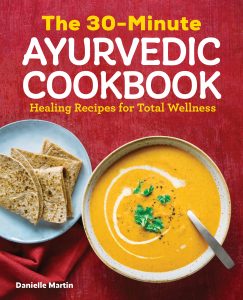 When it comes to healthy weight loss with lasting effects, Ayurveda holds great secrets to accomplishing your goal. By using this ancient wisdom and making the proper changes to your diet and lifestyle habits, you can shed those unwanted pounds and improve your overall health, energy, and vitality while doing so. Unlike many fad diets that tend toward the extreme, adopting healthy Ayurvedic practices is a smooth, steady way to lose weight, feel great, and transform your way of living!
When it comes to healthy weight loss with lasting effects, Ayurveda holds great secrets to accomplishing your goal. By using this ancient wisdom and making the proper changes to your diet and lifestyle habits, you can shed those unwanted pounds and improve your overall health, energy, and vitality while doing so. Unlike many fad diets that tend toward the extreme, adopting healthy Ayurvedic practices is a smooth, steady way to lose weight, feel great, and transform your way of living!
When it comes to weight loss, it is no surprise that the first area we should look at is our diet. According to Western science, 80% of weight loss comes from our dietary choices and only 20% from our exercise habits.* This very telling statistic shows that if you are exercising daily, but overeating or making poor food choices, weight loss is going to be a continuing battle for you. Therefore if you are serious about losing weight, it will be essential to make the dietary recommendations listed below a consistent part of your daily eating habits.
*This statistic comes from my studies of Exercise Science and Nutrition at the College of Charleston.
Weight loss is often accompanied by slow, sluggish digestion and metabolism, known as Manda Agni (lit slow fire). This means that you may not be eating much, but the pounds continue to add on. This can be very frustrating, confusing, and discouraging for many individuals. Therefore, the first line of action for weight loss should always focus on increasing the digestive fire (Agni) and clearing away toxins (ama) that can clog the channels of the digestive tract. With the synergistic approach listed below, making the proper dietary changes, adhering to the proper lifestyle practices, and including some essential herbal regimens, will aid in boosting digestion, revitalizing the metabolism, and creating healthy, sustainable weight loss.
Before we begin, I would like to offer a few words of wisdom. Although each recommendation is extremely important for the success of your weight loss goals, it will be equally as important to make these changes in a realistic manner. If you expect to make all of these changes overnight, you will likely end up overwhelmed with your new routine, especially if these recommendations are far from your current habits. Instead, I recommend choosing one to two recommendations per group (diet, lifestyle, herbs), turning these changes into a solid and consistent part of your schedule, and then steadily adding in more changes in time.
HELPFUL NOTE: In order to keep at a good pace, write down your current goals along with your future goals, listing specific dates for each. For example, you may choose to cut out all refined sugar straight away, while making the goal to “avoid all food after 6 pm” 2 weeks later. Using sticky notes, marking in your calendar, setting alarms, and creating other visual aids will be helpful to your success!
Read more on how to make steady, long-lasting changes here!
Effective Ways to Lose Weight (and Keep it Off!) with Ayurveda
1. Increase Light Foods in the Diet – Limit Heavy Foods
It may sound obvious, but light food will increase the light quality in your body and mind, while heavy foods will increase the heavy quality. Here is a list of recommended light foods to favor, and essential heavy foods to limit or avoid completely.
Light Foods To Favor:
- Non-starchy vegetables such as green beans, celery, spinach, cauliflower, and broccoli
- Bitter greens such as kale and collard greens
- Ginger, garlic, onion, chili pepper, and lemon
- Lighter whole grains such as quinoa, millet, buckwheat, and barley
- Lighter meats (in moderation) such as white chicken, white turkey, and non-oily fish/seafood
- Lighter oils (in moderation) such as ghee, sunflower oil, flax oil, and mustard seed oil
- Egg whites
- Goat dairy (in moderation)
- Fresh homemade kefir or yogurt
- Honey (in moderation)
- Digestive spices
Heavy Foods To Avoid:
- Red meat, pork, and lamb
- Egg yolks
- Cow dairy (small amounts of ghee is alright)
- Fatty, fried foods
- Refined foods (white bread, white sugar, white pasta)
- Processed foods (crackers, chips, bread, most things that come in a package. . .)
- Heavy grains such as wheat, gluten, oats, and white rice (small amounts of authentic basmati rice may be alright)
- Heavier oils such as butter, vegetable oil, shortening, and coconut oil
- Foods high in carbohydrates and starches
- Sweeteners such as white sugar, cane sugar, coconut sugar, date sugar. . . (honey is alright in moderation)
- Salty foods
- Store-bought yogurt
- Improper food combinations (get chart here)
2. Cut Out All Refined Sugar
This one is not so easy, but it is extremely powerful and effective for weight loss and overall health. Refined sugar is a mild poison to the system as it creates inflammation, toxins, blood sugar spikes (and crashes), and diminished energy. Just by doing this one recommendation alone, you will begin to feel lighter and more clear. Your digestion will improve, your metabolism will speed up, inflammatory issues will minimize, your appetite will be controlled better, and your sweet craving will eventually subside. Like many healthy changes, your body may feel worse before it feels better, but once you get over the slump, you will undoubtedly feel better than ever.
I suggest going cold turkey for this one once you are ready to take it on. To begin, you should remove any sugary temptations from your home or work area, and restock with healthier sweets* such as fruit, honey, and maple syrup. The cravings may worsen to begin but will begin to diminish after the initial phase of withdrawal is done.
Click here for more ideas on how to give up your sugar habit!
*All of our dessert recipes use natural sweeteners and absolutely no cane sugar or refined sugar. Get some healthy recipe ideas here.
3. Keep an Ideal Ratio for Each Meal
When determining your meals, creating a healthy ratio of food groups will fill you up without creating heaviness. By including a large serving of vegetables on your plate, you will receive a variety of vitamins, minerals, and fiber which will nourish you and create a healthy fullness. Lean proteins should also be favored since they are low in carbs and quite filling. Starchy or carb-rich foods should be limited to the lighter whole-grain options mentioned in number one and made the smallest portion of your meal.
Here is an ideal ratio for each meal for a healthy weight loss program:
- Colorful veggies – 50%
- Light, lean protein – 30%
- Light wholegrain carbs – 20% or less
Here are some examples for each meal:
BREAKFAST
- Egg white and vegetable omelet
- Sautéed kale and sweet potato egg scramble (using mostly egg whites)
- Springtime Breakfast Scramble
- Sweet Potato Millet Porridge
- Simply Spiced Quinoa Porridge
LUNCH
- Simply Steamed Veggies with a 4-ounce chicken breast or salmon (for meat eaters)
- Bowl of Red Lentil Dal (for vegetarians) with a 1/2 cup of spiced quinoa
- 2-cup portion of the Tridoshic Mung Dal and Quinoa Kitchari or Kapha-Reducing Kitchari
- 2-cup portion of Chickpea and Greens Brown Rice Bowl or Black-Eyed Pea and Kale Rice Bowl
- Bowl of millet (or buckwheat) with sautéed seasonal veggies and a handful of hemp seeds, pumpkin seeds, or almonds
DINNER
- A one-cup portion of the Classic Cleansing Kitchari
- Bowl of vegetable soup with extra veggies and a small amount of chicken or red lentils
- 4-ounce piece of baked salmon with a large portion of the Cooling Coconut Kale Sauté and a quarter cup of quinoa or millet
- Simply Steamed Veggies with Homemade Hummus
- Small cup of Veggie Soup or Tahini Broth
4. Add Spices to ALL of Your Meals
Adding cooking spices to your meals will help to increase your digestive fire (Agni) and lighten up any heavy qualities of the food. Adding cinnamon to your morning porridge; ginger, turmeric, and black pepper to your grain; or Agni Churna to your meat or fish is a simple and delicious way to help break down and assimilate your food better, which is essential for optimal metabolism and a healthy weight.
Here are some of the best spices for weight loss:
- Ginger
- Black pepper (freshly ground)
- Turmeric
- Cumin
- Brown mustard seed
- Garlic
- Cayenne pepper
- Kapha Churna
- Trikatu Churna
5. Make Lunch Your Largest Meal – Dinner the Lightest
Just as we need the proper ratios for each meal, we will also need the proper serving sizes. Making lunch the largest meal and dinner the lightest is not only essential for weight loss, but it is essential for optimal digestion, energy, and health.
So why is this universal recommendation such an important factor in our diet? The digestive fire is burning its strongest between the hours of 11 am and 1 pm, making it the best time to eat your largest meal, as well as the best time to eat heavier foods such as meat, grains, sweets, and dairy. Although these heavier foods should still be limited, this is the best time for them when they are to be eaten.
Alternatively, the digestive fire is at its lowest point at the end of the day, especially after the sun has set. We are also more prone to sedentary activities in the evening. Eating heavy foods or a large meal at the end of the day is a recipe for disaster, as these foods often end up sitting in your gut until morning, or endure a much longer transit time otherwise. Whatever the case, this very detrimental habit leads to a diminished metabolism, toxic build-up, and weight gain.
6. Avoid All Food After 6 pm
By eating all of your food by 6 pm, you will have plenty of time to digest before you lay down for the evening (granted you are eating lighter foods and moderate portions). Since many individuals make their worst food choices after sunset, establishing this rule will help to phase out your evening sweet tooth or junk food habit. Although dinner should be light, make sure it is nourishing and fulfilling in order to sustain your hunger until morning. If needed a cup of broth, a cup of herbal tea with honey, or a small piece of a lower-sugar fruit* (e.g. apple, pear, berries) can be taken.
*Only eat fruit if it has been at least 2 hours after consuming any other food to avoid a major improper food combination.
7. Avoid All Snacking and Grazing
One of the biggest downfalls to weight loss is the habit of snacking and grazing. Since our main goal for weight loss is to improve digestion, we must allow proper time between meals to give our hard-working digestive fire a break. Since an average meal takes at least 5 to 6 hours to digest, we must be diligent to not eat before this time frame. Other ill effects of snacking include reduced metabolism, toxic build-up, weakened pancreas, poor food choices, improper food combinations, overeating, eating without true hunger, and symptoms of indigestion (gas, bloating, hyperacidity, dull appetite, constipation, etc).
If you are eating the healthy ratios mentioned above (see number three), a large amount of fiber and lean protein should help to sustain your hunger and energy between meals. If you are still finding yourself with unabiding hunger, then taking in some ginger tea with honey; a cup of CCF Tea; a cup of broth; or a handful of berries can be a good compromise.
8. Avoid Cold Beverages – Drink Hot Water Between Meals
This is another important guideline that may take some getting used to for many people. Drinking excessively cold or iced beverages is a direct way to douse your digestive fire, slow down your metabolism, and create indigestion and toxic accumulation in your gut. All of these factors will lead to weight gain, especially if you are already prone to this in the first place. Alternatively, drinking warm to hot water between meals will improve digestion and metabolism while gently flushing out the system.
To put this into a more clear perspective, imagine that you are washing dishes. If you have old food or oil stuck to a dish, washing it with cold water will not allow the dish to get clean and in the case of oil, will actually create more viscosity. If you use hot water, however, you can steadily pour this over the old food and oil, and even without effort, the dish will soon become clean.
Read more tips on how to hydrate properly here!
9. Perform Kapalabhati Pranayama Before Meals
Kapalabhati (pronounced “ka-pa-la-bha-tee”) is an ancient breathing technique that is specific for increasing the fire in the system. Since our main fire is the Agni (digestive fire), performing this breathwork before each meal will ignite your digestion and allow you to metabolize your food properly. This means you will burn your calorie intake more efficiently and the food will move through your system at a quicker speed, eventually leading to weight loss and increased energy.
If you are new to this breathing technique, you can begin slowly by performing two rounds of 27 breaths, 15 minutes before your meals. Once the breathing becomes more comfortable, increase this to four rounds of 27 breaths. If appropriate, this can then be increased to two rounds of 54 or even one round of 108. If there is any labor or anxiety that is arising from this work, however, reduce the amount until you find comfort in your practice.
Get full instructions for Kapalabhati here.
10. Perform 30 Minutes of Exercise EVERY DAY
This guideline may need to be slowly obtained, but it is indeed essential for a healthy weight (and our overall health) to get at least 30 minutes of intentional movement each and every day. During the weight loss phase, this should include 3 to 5 days of mild to intense cardio to get the blood flowing, the sweat going, and the metabolism revved up. This should be mainly non-weight-bearing exercises such as swimming, elliptical, biking, or similar options. Exercise classes, exercise videos, YouTube videos, and faster-paced Yoga classes are also great options as well. However, the best option of all (with no excuses allowed!) is the simple, age-old practice of a brisk walk. To enhance the weight loss benefits of your walk, schedule it after your meal to aid in digestion and metabolism.
11. Avoid Daytime Sleep (especially after meals!)
Daytime sleeping is very frowned upon in Ayurveda, especially for those with a Kapha imbalance such as excessive weight. This habit will slow down the metabolism even further and create heaviness and congestion in the body and mind. If you have the urge to fall asleep during the daytime, try to counterbalance it with a brisk walk in the fresh air, a cup of extra-potent ginger tea, a trip to the gym, an upbeat Yoga class, some deep breathing (or Kapalabhati!), or an impromptu stretching session.
12. Take Trikatu Churna Before Meals
Trikatu is a blend of ginger, black pepper, and pippali (Indian black pepper) and is the traditional formula for increasing digestion and metabolism, reducing cholesterol, losing weight, removing congestion, and balancing Kapha dosha.
Directions: For weight loss, take 1/2 to 1 teaspoon of Trikatu Churna mixed in a small spoonful of honey before each meal; wash it down with a few sips of warm water.
Try my organic, in-house ground Trikatu Churna!
Read more on the health benefits of Trikatu here.
13. Drink an ACV, Honey, and Lemon Tonic Three Times Daily
This fairly well-known concoction is cleansing, reducing, and naturally energizing. By drinking this tonic first thing in the morning on an empty stomach, and again between each meal, you will begin to flush out the system, boost the digestive fire, and speed up the metabolism.
Directions: For weight loss, take 12 ounces of hot (but not boiling) water and add in 1 teaspoon of honey, 1 teaspoon of apple cider vinegar, and juice from 1/4 of a lemon. Drink this first thing each morning, between breakfast and lunch, and again between lunch and dinner. Alternatively, the Kapha-Balancing Tonic can be taken at the same recommended times.
Get our Kapha-Balancing Tonic recipe here!
14. Take Triphala Churna Before Bed
Triphala is the universal formula for flushing out the GI tract, strengthening and cleansing the liver, boosting digestion, and promoting healthy elimination. Best of all, it is filled with antioxidants and vitamin C making it an all-around health tonic that is often gentle enough to take for a lifetime.
Directions: For weight loss, add 1 teaspoon of Triphala Churna and 1 teaspoon of honey to 1/2 cup of hot (not boiling) water. Stir well and let steep for 5 minutes. Stir again and drink, making sure to consume all of the herbs. Take this each night before bed for a cleansing boost throughout the night and a healthy bowel movement in the morning.
Try my organic, hand-blended Triphala Churna!
Read more on the health benefits of Triphala here.
Conclusion
Ayurveda uses a healthy, slow-but-steady approach to weight loss that will take effort and patience, but will grant you long-lasting permanent changes in the end. By using a holistic approach and making the appropriate diet, lifestyle, and herbal habits a regular part of your routine, you can begin to lose weight, boost your energy levels, and create optimal health for years to come. In weight loss or any other healthcare goal, Ayurveda is not a temporary fix, but rather a way of living your life to its fullest potential.
Discover over 100 Ayurvedic home remedies in my “Ayurvedic Herbal Medicine for Beginners” book!*
Discover healing recipes with my 30-Minute Ayurvedic Cookbook!*
*By ordering directly through these links, you are helping to support Svastha Ayurveda – Thank you!!





Hello,
Thank you for your articles and insights. I love your products and use them for myself, my partner and my dog. 🙂
I am hypoglycemic and so taking honey with multiple things 7 times per day isn’t realistic for me (ACV tonic 3x, Trikatu 3x and Triphala 1x).
I simply do the Trikatu and Triphala in warm water. Do you suggest any adjustment to the tonic’s sweetness as well?
H Koa,
Thank you for this great question! The honey is included in these herbal treatments due to the “scraping” quality it possesses. This quality is very unique to honey, making it one of the only acceptable sweeteners in weight loss. However, if honey is not a possibility for your healthcare needs, then taking the Trikatu and the Triphala in 1/2 cup of warm water, steeping them for a few minutes, stirring, and drinking them down will be best.
In regards to the ACV tonic, the honey should also be omitted. You can either keep it unsweetened, or use a natural, sugar-free option such as stevia or inulin. Other sweeteners such as maple syrup or organic cane sugar are simply not recommended to take regularly during weight loss.
Please let me know if you have any further questions!
Namaste,
Danielle
Awesome, thank you for helping me understand the role of the honey more clearly in the process. I can easily do stevia in the ACV tonic! Thank you!
How long after a meal should you wait to drink the acv tonic?
Hi Charlie,
Thank you for your question! Since it is not recommended to drink fluids directly after a meal, I would suggest to wait at least 1 to 2 hours post-meal to ensure that the food has made its way out of the stomach. The larger the meal, the longer I would suggest to wait. Please let me know if you have any further questions!
Be well:)
Namaste,
Danielle